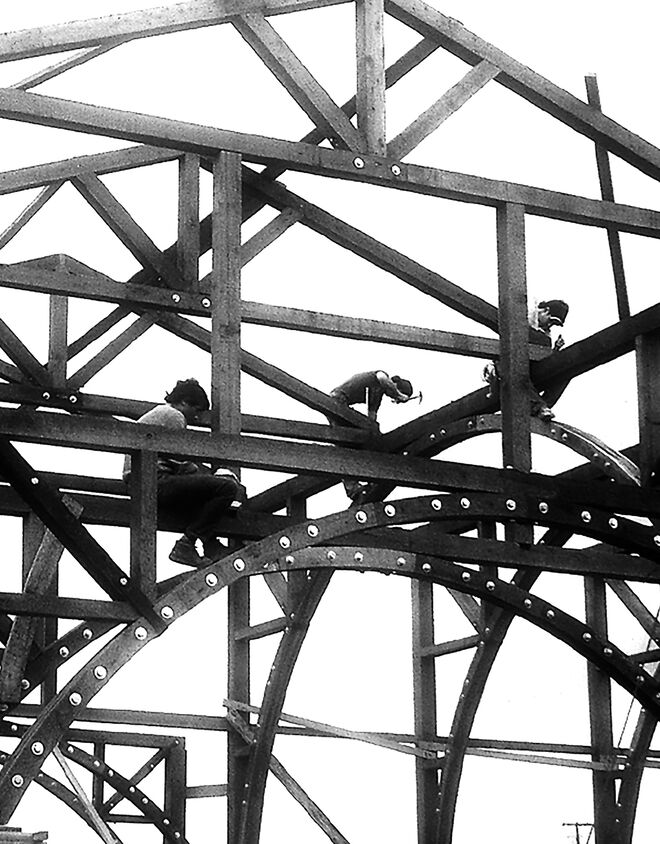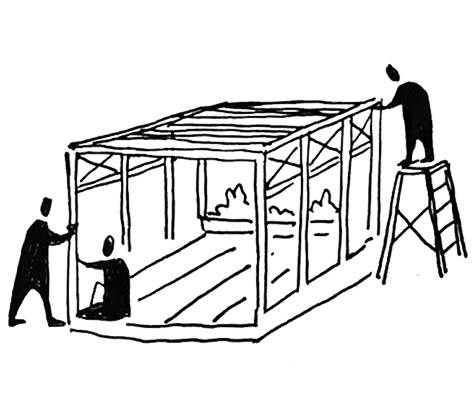15.1. Design-Build Adaptation
Aus Pattern Language Wiki
(Weitergeleitet von .../Design-Build Adaptation)
In order to get the richest quality of Biophilic Urbanism and high quality buildings, assure that the construction process is be able to evolve and respond to context as it proceeds.
Problem-statement: There is an important quality in buildings that respond to the evolutionary opportunities of their context during construction. Yet a design-build approach can introduce uncertainty, complexity and cost into the construction process.
Discussion: Some of the most beautiful and successful buildings in the world have been produced from a design-build process. The great medieval cathedrals are a case in point: often construction commenced with little more than a floorplan and an elevation of a single bay, drawn with ink on plaster. Many hundreds of shop drawings, models and mockups followed, and the beautiful results emerged out of that careful evolutionary process.
At the same time, design-build approaches can be expensive if they are not managed well. The critical issue is the governance of changes, in such a way that any change does not introduce additional cost and/or time, over what has been planned. This can be done if managed carefully.¹
We are beginning to realize that there is a relationship between our most successful constructions — as measured by user health and satisfaction — and the processes of biology. In these biological systems, we learn a profound lesson from their process of growth with adaptation, where every step in development checks against the latent coherence of the emerging whole. In a “linear” or mechanistic process, by contrast, a structure is built strictly according to a blueprint. This makes it impossible to adjust a design by using feedback while it is being carried out. The result is that we lose a powerful capacity for adapting much more closely to human sensibilities. Yet as we can see from historical examples, this method has led to exquisite results. The challenge now is to make the extra effort to implement a procedure with greater feedback in shaping a better-quality built environment.
Therefore:
Incorporate a design-build methodology into construction processes. Use an interactive collaboration between designers, builders and craftspeople, looking on site for emergent opportunities and combinations.
Use Community Mockup to judge the results of design changes in their actual contexts. …
¹ There is a great deal of literature on the design-build process — see for example Chan, A. P., Scott, D., & Lam, E. W. (2002). Framework of success criteria for design/build projects. Journal of Management in Engineering, 18(3), 120-128.
Mehaffy, M. et al. (2020). DESIGN-BUILD ADAPTATION (pattern). In A New Pattern Language for Growing Regions. The Dalles: Sustasis Press. Available at https://pattern-language.wiki/.../Design-Build_Adaptation
SECTION I:
PATTERNS OF SCALE
1. REGIONAL PATTERNS
Define the large-scale spatial organization…
1.4. 400M THROUGH STREET NETWORK
2. URBAN PATTERNS
Establish essential urban characteristics…
3. STREET PATTERNS
Identify and allocate street types…
4. NEIGHBORHOOD PATTERNS
Define neighborhood-scale elements…
5. SPECIAL USE PATTERNS
Integrate unique urban elements with care…
6. PUBLIC SPACE PATTERNS
Establish the character of the crucial public realm…
7. BLOCK AND PLOT PATTERNS
Lay out the detailed structure of property lines…
8. STREETSCAPE PATTERNS
Configure the street as a welcoming place…
9. BUILDING PATTERNS
Lay out appropriate urban buildings…
10. BUILDING EDGE PATTERNS
Create interior and exterior connectivity…
10.1. INDOOR-OUTDOOR AMBIGUITY
SECTION II:
PATTERNS OF MULTIPLE SCALE
11. GEOMETRIC PATTERNS
Build in coherent geometries at all scales…
11.2. SMALL GROUPS OF ELEMENTS
12. AFFORDANCE PATTERNS
Build in user capacity to shape the environment…
13. RETROFIT PATTERNS
Revitalize and improve existing urban assets …
14. INFORMAL GROWTH PATTERNS
Accommodate “bottom-up” urban growth…
15. CONSTRUCTION PATTERNS
Use the building process to enrich the result…
SECTION III:
PATTERNS OF PROCESS
16. IMPLEMENTATION TOOL PATTERNS
Use tools to achieve successful results…
16.2. ENTITLEMENT STREAMLINING
16.3. NEIGHBORHOOD PLANNING CENTER
17. PROJECT ECONOMICS PATTERNS
Create flows of money that support urban quality…
17.4. ECONOMIES OF PLACE AND DIFFERENTIATION
18. PLACE GOVERNANCE PATTERNS
Processes for making and managing places…
18.3. PUBLIC-PRIVATE PLACE MANAGEMENT
19. AFFORDABILITY PATTERNS
Build in affordability for all incomes…
19.1. INTEGRATED AFFORDABILITY
20. NEW TECHNOLOGY PATTERNS
Integrate new systems without damaging old ones…
20.2. RESPONSIVE TRANSPORTATION NETWORK COMPANY

